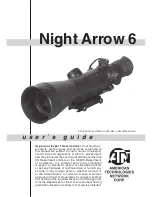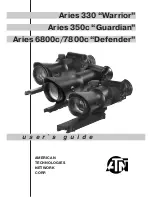
19
The large primary mirror and the elliptical secondary mirror of
your telescope are front-surface aluminized and over-coated
with hard silicon dioxide, which prevents the aluminum from
oxidizing. These coatings normally last through many years of
use before requiring re-coating (which is easily done).
To clean the secondary mirror, first remove it from the tele-
scope. Do this by holding the secondary mirror holder station-
ary while turning the center Phillips-head screw. Be careful,
there is a spring between the secondary mirror holder and the
Philips-head screw; be sure that it will not fall into the optical
tube and hit the primary mirror. Handle the mirror by its hold-
er; do not touch the mirror surface. Then follow the same pro-
cedure described below for cleaning the primary mirror. You
do not need to remove the secondary mirror from its holder
when cleaning.
To clean the primary mirror, carefully remove the mirror cell
from the telescope. To do this means you must remove the six
screws on the side of the tube near the primary mirror. You do
not need to remove the collimation screws on the bottom of
the mirror cell. Remove the mirror cell from the tube. You will
notice the primary mirror is held down with four clips held by
two screws each. Loosen the screws and remove the clips.
You may now remove the mirror from the mirror cell. Do not
touch the surface of the mirror with your fingers. Lift the mirror
carefully by the edges. Set the mirror on a clean soft towel. Fill
a clean sink free of abrasive cleanser, with room-temperature
water, a few drops of liquid dishwashing detergent, and if pos-
sible, a capful of rubbing alcohol. Submerge the mirror (alu-
minized face up) in the water and let it soak for a few minutes
(or hours if it’s a very dirty mirror). Wipe the mirror under
water with clean cotton balls, using extremely light pressure
and stroking in straight line across the mirror. Use one ball for
each wipe across the mirror. Then rinse the mirror under a
stream of lukewarm water. Any particles on the surface can
be swabbed gently with a series of cotton balls, each used
just one time. Dry the mirror in a stream of air (a “blower bulb”
works great), or remove any stray drops of water with the cor-
ner of a paper towel. Water will run off a clean surface. Cover
the mirror surface with Kleenex, and leave the mirror in a
warm area until it is completely dry before reassembling the
telescope.
11. Specifications
Primary mirror diameter: 254mm
Primary mirror coating: Aluminized, SiO2 overcoat
Primary mirror material: Pyrex
®
Focal length: 1200mm
Focal ratio: f/4.7
Secondary mirror axis: 64mm
Secondary mirror holder: Four-vaned spider
Eyepiece: 25mm and 10mm Sirius Plössls, fully coated,
1.25"
Magnification: 48x (with 25mm) and 120x (10mm)
Finder scope: 9x50 achromatic, 5° field of view
Focuser: Rack and pinion, push-pull tilt adjustment for
collimating, accepts 2" and 1.25" eyepieces
Camera adapter: couples 35mm SLR camera T-Ring to
focuser
Mount: Atlas, German equatorial
Tripod: Steel
Tripod support tray: Aluminum, provides additional stability,
holds five 1.25" eyepeices and two 2" eyepieces
Weight: 54 lbs.
Counterweights: Quantity 3, 11 lbs. each
Setting circles: R.A. scaled in 10 min. increments, Dec.
scaled in 2° increments for N or S hemisphere
Polar axis latitude adjustment: 10° to 65°
Polar axis finder scope: Included
Motor drives: Dual-axis, internally housed
Power requirements: 12V DC, tip positive
Battery type: Eight D-cells
Operation: Northern or Southern hemisphere
Guiding rates: Sidereal ±100% sidereal
Centering rates: ±8x sidereal, ±16x sidereal



























